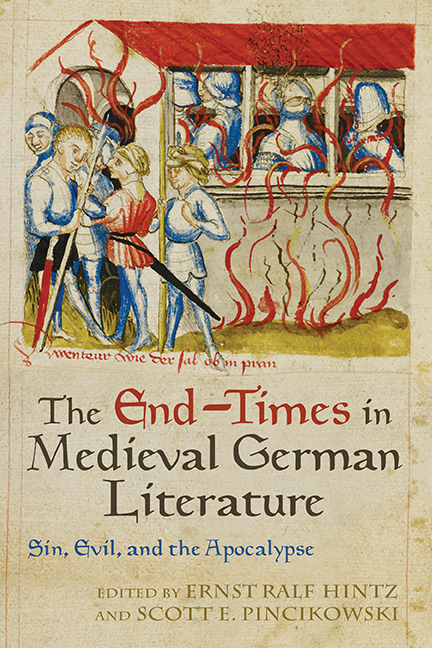Book contents
- Frontmatter
- Dedication
- Contents
- Acknowledgments
- Introduction
- 1 Thiu wirsa giburd: Cain’s Legacy, Original Sin, and the End of the World in the Old Saxon Genesis
- 2 The Heliand Revisited: Spiritual Transgendering and the Defiance of Evil
- 3 The Beginning of the End: Binary Dynamics and Initiative in Hartmann von Aue’s Gregorius
- 4 Poetic Reflections in Medieval German Literature on Tragic Conflicts, Massive Death, and Armageddon
- 5 Beyond Good and Evil: Apocalyptic Vision without Judgment in the Nibelungenlied. An Essay
- 6 End-Times in the Hall: The Modern Reception of the Apocalyptic Ending of the Nibelungenlied
- 7 Past Present, Future Present? Visualizing Arthurian Romance and the Beholder’s Share in a World That Refuses to End
- 8 Ich diene und wirbe / biz ich gar verdirbe: Lovesickness, Apocalypse, and the End-Times in Mauritius von Craûn and Das Nibelungenlied
- 9 The Slippery Concept of Evil in Hartmann von Aue’s Erec and Iwein
- 10 Wigamur’s Lessons on the Complexity of Evil
- 11 The Miracles of the Antichrist
- 12 Monsters and Monstrosities in the Pamphlet Wars of the Reformation
- Notes on the Contributors
- Index
11 - The Miracles of the Antichrist
Published online by Cambridge University Press: 21 March 2020
- Frontmatter
- Dedication
- Contents
- Acknowledgments
- Introduction
- 1 Thiu wirsa giburd: Cain’s Legacy, Original Sin, and the End of the World in the Old Saxon Genesis
- 2 The Heliand Revisited: Spiritual Transgendering and the Defiance of Evil
- 3 The Beginning of the End: Binary Dynamics and Initiative in Hartmann von Aue’s Gregorius
- 4 Poetic Reflections in Medieval German Literature on Tragic Conflicts, Massive Death, and Armageddon
- 5 Beyond Good and Evil: Apocalyptic Vision without Judgment in the Nibelungenlied. An Essay
- 6 End-Times in the Hall: The Modern Reception of the Apocalyptic Ending of the Nibelungenlied
- 7 Past Present, Future Present? Visualizing Arthurian Romance and the Beholder’s Share in a World That Refuses to End
- 8 Ich diene und wirbe / biz ich gar verdirbe: Lovesickness, Apocalypse, and the End-Times in Mauritius von Craûn and Das Nibelungenlied
- 9 The Slippery Concept of Evil in Hartmann von Aue’s Erec and Iwein
- 10 Wigamur’s Lessons on the Complexity of Evil
- 11 The Miracles of the Antichrist
- 12 Monsters and Monstrosities in the Pamphlet Wars of the Reformation
- Notes on the Contributors
- Index
Summary
THE VIVID IMAGES of the Puch von dem Entkrist, their simplicity and starkness, are mesmerizing. The colors leap off the pages, and before even reading the text, one is drawn into the story that they tell. What must have been the emotional reaction of a fifteenth-century reader? Someone immersed in the religious background of the Final Enemy? The Puch von dem Entkrist is part of a series of German blockbooks that detail the life of the Antichrist and the Fifteen Signs of Doomsday. Along with it, there is the Frankfurt edition that is a full print and the earlier chiro-xylographic Antichrist. All three are fascinating, but they contain one particular set of images that puzzle scholars to this day.
The German blockbooks detailed the life of the Antichrist and combined his legend with the popular countdown of the Fifteen Signs of Doomsday. In the first part, the Antichrist performs three miracles in front of an enthralled audience of followers. His goal is to blind and seduce them so that they believe his lies and deceit. But why would he conjure a giant from an egg, suspend a castle by a thread in the air, and draw a stag from a stone? They do not belong to the established eschatological tradition. Before and after this set of images, he performs other miracles as well; those miracles are drawn from eschatological tradition, but these are not. Their particularity must be explained in the cultural context of the fifteenth century. Therefore, the discussion has to turn to the question of how apocalyptic texts were used in the fifteenth century and how far the blockbooks reflect that culture. Christoph Peter Burger states in his introduction to the Frankfurter Blockbuch:
Ein uns unbekannter Verfasser schrieb zu Beginn des fünfzehnten Jahrhunderts (die ältesten Handschriften werden auf 1430 datiert) unter Benutzung verschiedener Quellen, besonders aber des Compendium der theologischen Wahrheit des Straßburger Dominikaners Hugo Ripelin (gest. 1268) und der Legenda Aurea des Genueser Dominikaners Jacobus de Voraigne (1228/30–1298), einen Bildertext, in dem er die beiden miteinander verwandten Legenden vom Antichrist und den fünfzehn Zeichen in deutscher Sprache erzählte.
- Type
- Chapter
- Information
- The End-Times in Medieval German LiteratureSin, Evil, and the Apocalypse, pp. 238 - 254Publisher: Boydell & BrewerPrint publication year: 2019



